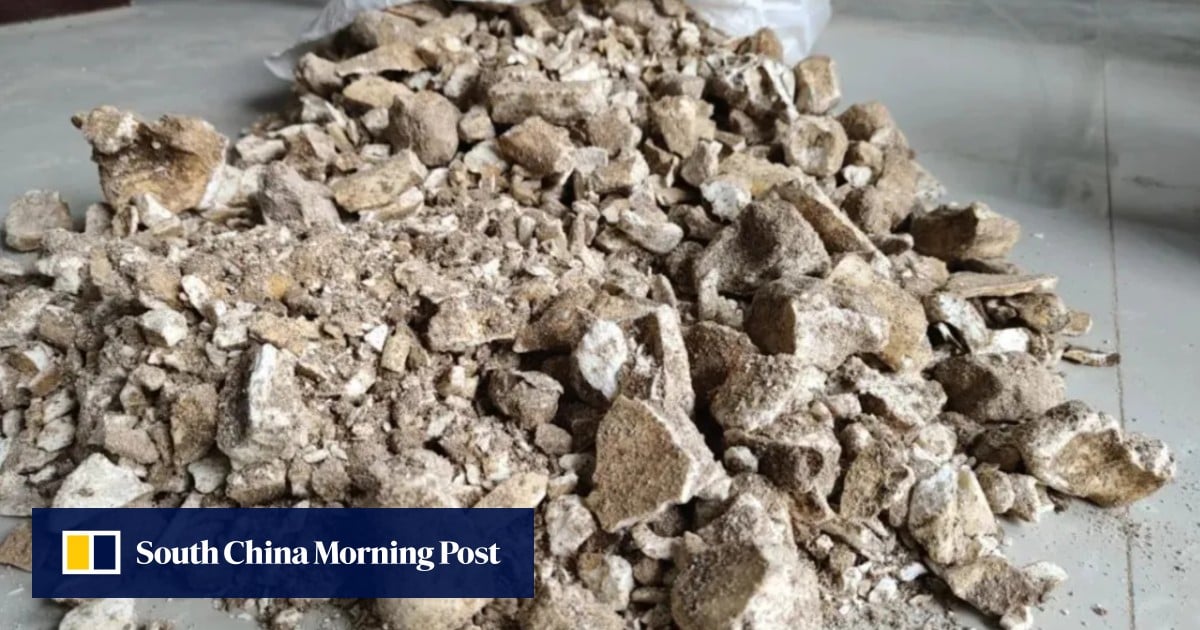The department alleged the group arrested had been active since last year, targeting areas without a communication signal and transport access to dig for fossils to sell.
They say the accused, who were not known to locals and whose accent indicated they were not from the area, raised suspicions among residents who alerted the authorities.
Recent reports show fossils are being looted from various regions of China, including Inner Mongolia autonomous region and the provinces of Ningxia and Yunnan, which are less-developed areas.
Most poached dragon bone fossils have been dated to the current Quaternary period which began around 2.6 million years ago, according to a researcher at the Chinese Academy of Sciences’ Institute of Vertebrate Palaeontology and Palaeoanthropology.
“The relatively recent origin means that the proportion of scientifically valuable materials among them is reasonably low, but it’s likely that some precious fossils will be lost,” the researcher said, declining to be named.
It is not known where dragon bones are being sent. However, a palaeontologist based in Gansu province and who also did not wish to be named, was quoted by Chinese media outlet Red Star News this month suggesting that most were likely to end up at places involved in processing traditional Chinese medicine, while a smaller portion might be collected as fossil specimens.
According to media reports in Henan province in 2007, villagers were not aware the “magical stones” they had been using as medicine for generations were dinosaur fossils.
The calcium-rich bones were sometimes boiled with other ingredients and used to treat various ailments, or ground into a paste and applied directly to fractures and injuries. Villagers also sold them at low prices to herbal drug shops in the area.
At the time, scientists announced the discovery of more than 10 types of dinosaur and other animal fossils in the Ruyang and Luanchuan regions of Henan, including Asia’s largest dinosaur at the time, which raised international attention in the scientific community.
China’s golden age of archaeology becomes a national obsession
China’s golden age of archaeology becomes a national obsession
One leading scientist, Dong Zhiming, who was working at the institute at the time, said dinosaur fossils were petrified and had virtually no medicinal value, yet local people had been excavating and selling them as dragon bones and causing significant damage.
In 2011, China began implementing legislation to protect fossils, including the dragon bones.
Additionally, since 1977 fossils have been excluded from the Chinese Pharmacopoeia, reflecting a commitment to “protecting wild resources and the natural environment” and promoting the sustainable development of traditional Chinese medicine.
Despite these measures, the excavation and trade of the fossils have continued, albeit in a more underground manner. Poachers venture into hard-to-reach areas, often in mountainous regions, in search of dragon bones.
“Unlike dinosaur fossil sites, Quaternary fossil sites are relatively abundant, and thus it’s impossible to invest equal manpower and resources in protecting them,” the researcher from the institute said, adding that the challenge was compounded by market demand and economic incentives.
A professor from Shanghai University of Traditional Chinese Medicine who asked to remain anonymous said the effectiveness of dragon bones in traditional medicine was debatable and required further research.
Even if proven effective, he stressed, alternatives existed and researchers were exploring substitutes. For example, some Chinese researchers have suggested that oyster shell could be a substitute for dragon bones.
The traditional medicine expert also mentioned that restrictions on illegal extractions had led to counterfeit products appearing on the market, typically created by blending yellow soil with binders and fragments of dragon bones.
Demand for Chinese medicine fuelling illicit African donkey trade
Demand for Chinese medicine fuelling illicit African donkey trade
The researcher from the institute said the relationship between the fossil trade and scientific research was complicated. Historically, such as in times of war, digging up animal fossils was restricted so shops selling dragon bones became an important destination for scientists seeking research material.
“But today, we hope that fossils can be dug up in a scientific manner because some critical information, such as the geological environment and strata in which fossils are buried, can be lost due to amateur excavation,” he said.
